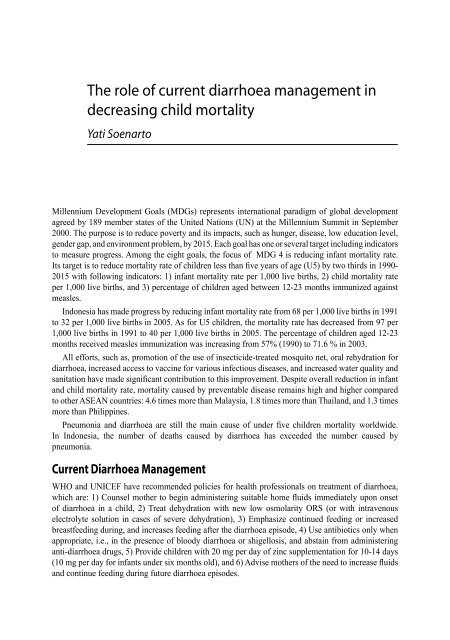South-East Asia Regional Conference on Epidemiology
South-East Asia Regional Conference on Epidemiology
South-East Asia Regional Conference on Epidemiology
Create successful ePaper yourself
Turn your PDF publications into a flip-book with our unique Google optimized e-Paper software.
The role of current diarrhoea management in<br />
decreasing child mortality<br />
Yati Soenarto<br />
Millennium Development Goals (MDGs) represents internati<strong>on</strong>al paradigm of global development<br />
agreed by 189 member states of the United Nati<strong>on</strong>s (UN) at the Millennium Summit in September<br />
2000. The purpose is to reduce poverty and its impacts, such as hunger, disease, low educati<strong>on</strong> level,<br />
gender gap, and envir<strong>on</strong>ment problem, by 2015. Each goal has <strong>on</strong>e or several target including indicators<br />
to measure progress. Am<strong>on</strong>g the eight goals, the focus of MDG 4 is reducing infant mortality rate.<br />
Its target is to reduce mortality rate of children less than five years of age (U5) by two thirds in 1990-<br />
2015 with following indicators: 1) infant mortality rate per 1,000 live births, 2) child mortality rate<br />
per 1,000 live births, and 3) percentage of children aged between 12-23 m<strong>on</strong>ths immunized against<br />
measles.<br />
Ind<strong>on</strong>esia has made progress by reducing infant mortality rate from 68 per 1,000 live births in 1991<br />
to 32 per 1,000 live births in 2005. As for U5 children, the mortality rate has decreased from 97 per<br />
1,000 live births in 1991 to 40 per 1,000 live births in 2005. The percentage of children aged 12-23<br />
m<strong>on</strong>ths received measles immunizati<strong>on</strong> was increasing from 57% (1990) to 71.6 % in 2003.<br />
All efforts, such as, promoti<strong>on</strong> of the use of insecticide-treated mosquito net, oral rehydrati<strong>on</strong> for<br />
diarrhoea, increased access to vaccine for various infectious diseases, and increased water quality and<br />
sanitati<strong>on</strong> have made significant c<strong>on</strong>tributi<strong>on</strong> to this improvement. Despite overall reducti<strong>on</strong> in infant<br />
and child mortality rate, mortality caused by preventable disease remains high and higher compared<br />
to other ASEAN countries: 4.6 times more than Malaysia, 1.8 times more than Thailand, and 1.3 times<br />
more than Philippines.<br />
Pneum<strong>on</strong>ia and diarrhoea are still the main cause of under five children mortality worldwide.<br />
In Ind<strong>on</strong>esia, the number of deaths caused by diarrhoea has exceeded the number caused by<br />
pneum<strong>on</strong>ia.<br />
Current Diarrhoea Management<br />
WHO and UNICEF have recommended policies for health professi<strong>on</strong>als <strong>on</strong> treatment of diarrhoea,<br />
which are: 1) Counsel mother to begin administering suitable home fluids immediately up<strong>on</strong> <strong>on</strong>set<br />
of diarrhoea in a child, 2) Treat dehydrati<strong>on</strong> with new low osmolarity ORS (or with intravenous<br />
electrolyte soluti<strong>on</strong> in cases of severe dehydrati<strong>on</strong>), 3) Emphasize c<strong>on</strong>tinued feeding or increased<br />
breastfeeding during, and increases feeding after the diarrhoea episode, 4) Use antibiotics <strong>on</strong>ly when<br />
appropriate, i.e., in the presence of bloody diarrhoea or shigellosis, and abstain from administering<br />
anti-diarrhoea drugs, 5) Provide children with 20 mg per day of zinc supplementati<strong>on</strong> for 10-14 days<br />
(10 mg per day for infants under six m<strong>on</strong>ths old), and 6) Advise mothers of the need to increase fluids<br />
and c<strong>on</strong>tinue feeding during future diarrhoea episodes.









